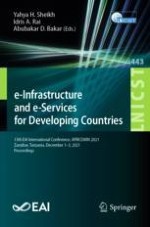2022 | OriginalPaper | Chapter
Review of Markov Chain and Its Applications in Telecommunication Systems
Authors : Amel Salem Omer, Dereje Hailemariam Woldegebreal
Published in: e-Infrastructure and e-Services for Developing Countries
Publisher: Springer International Publishing
Activate our intelligent search to find suitable subject content or patents.
Select sections of text to find matching patents with Artificial Intelligence. powered by
Select sections of text to find additional relevant content using AI-assisted search. powered by
